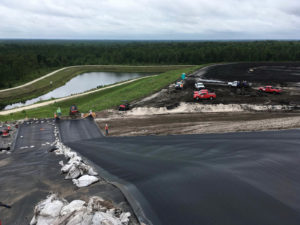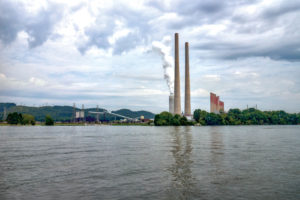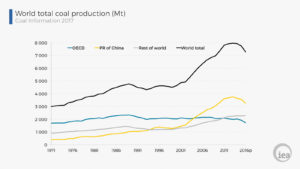
As discussed in Part 1 of “The Regulation of CCR in the United States,” for the first time in decades, nationwide regulation of CCR (coal combustion residuals) surface impoundments expands the regulated use of geosynthetic materials. While the CCR Rule (2015) allows continued operation of existing CCR surface impoundments, it provides criteria for the disposition of the inactive and active fleet of surface impoundments. Time frames for the initiation of closure are established for units no longer harvesting CCR for beneficial use, for units no longer receiving CCR and for units that become temporarily idle.
In addition to closures triggered by operational criteria, closures may be triggered by technical criteria contained in the CCR Rule. An owner must initiate closure within six months when a CCR unit:
- fails to meet established location criteria
- contaminates groundwater and is an unlined surface impoundment
- fails to demonstrate minimum factors of safety for structural integrity
Inactive CCR surface impoundments—units that ceased to receive CCR after Oct. 19, 2015, but still contained water and CCR—were required to meet all applicable regulatory requirements. During the CCR assessment period, the U.S. Environmental Protection Agency (EPA) concluded that inactive CCR surface impoundments that had not completed closure consistent with the standards being promulgated posed significant risk.
To encourage owners to rapidly close the inactive units to the performance standards in the Code of Federal Regulations Title 40 Part 257.102 (the Code), the EPA provided exemption from the remaining requirements (e.g., groundwater monitoring and post-closure care) of the CCR Rule if an inactive surface impoundment closed by April 2018 uses the processes contained in the CCR Rule.
In respect to inactive surface impoundments, industry groups have challenged the EPA’s authority to regulate them at all, and environmental groups challenged the exemption from the CCR Rule for inactive CCR surface impoundments appropriately closed by April 2018.
The extent of the EPA’s authority and the means it employs to establish regulation of activities affecting the environment result from interpretation of the pertinent laws passed by Congress and from the case law emanating from challenges brought to agency interpretations of those laws.
Shortly after promulgation of the CCR Rule, industry and environmental groups filed a series of challenges to the EPA’s interpretations of law supporting the recently established CCR regulations. The actions were consolidated into a single case in the United States Court of Appeals for the District of Columbia Circuit.
Current status

As of this writing, the question of the EPA’s authority to regulate inactive CCR surface impoundments remains an open issue before the court. But, on April 18, 2016, the EPA filed a motion with the court to vacate the exemptions for rapidly closed inactive CCR surface impoundments because the “EPA did not provide notice or opportunity to comment on this exemption during the rulemaking”—seemingly a procedural reason. There were no objections to the EPA’s motion, but the court has yet to accept the motion.
The impact of eliminating the exemption has more to do with when closure projects will be executed than if the closure projects will be executed. Geosynthetic materials will be used in roughly the same proportion of projects, but the market impact from closure of inactive CCR surface impoundments will be extended in time.
Once undertaken or triggered, closure of a surface impoundment may be accomplished via clean closure or waste-in-place closure. The choice of the most appropriate method of closure is left to the owner. If a clean closure is chosen or otherwise mandated, as it is in North Carolina, the excavated CCR material must be either beneficially reused or disposed of in a lined landfill/structural fill in accordance with the CCR Rule.
Waste-in-place closures of surface impoundments and landfills are regulated to the same standards. The CCR Rule sets out minimum standards for the design, execution and operation of the cover system. The minimum standards are based upon practices found to contribute to the long-term performance of the closed facility.
Owners and operators must ensure that closure systems for such CCR facilities will, at a minimum, comply with the performance standards identified by Part 257.102(d)(1) of the Code:
- control, minimize or eliminate, to the maximum extent feasible, post-closure infiltration of liquids into the waste and releases of CCR, leachate or contaminated run-off to the ground, surface waters or atmosphere
- preclude the probability of future impoundment of water, sediment or slurry
- include measures that provide for major slope stability to prevent the sloughing or movement of the final cover system during the closure and post-closure care period
- minimize the need for further maintenance of the CCR unit
- be completed in the shortest amount of time consistent with recognized and generally accepted good engineering practices
To emphasize the long-term performance of the cover system, the EPA modeled the closure performance standard after Part 265.111 of the Code dealing with interim status hazardous waste units: “Under this performance standard, if the cover system results in liquids infiltration or releases of leachate from the CCR unit, the final cover would not be an appropriate cover.”
So, in addition to meeting the cover system criteria, owners and engineers are required to “account for any condition that may cause the final cover system not to perform as designed.” A professional engineer (P.E.) is required to certify that the cover system design meets both the cover system criteria and the cover system performance standard.
In the CCR Rule, the EPA relies on P.E. certification to set performance standards instead of being overly prescriptive as to the cover system design. Engineers and owners may apply a soil cover system, provided the soil infiltration layer has a permeability less than or equal to the bottom liner or natural subsoils at the base of the unit. In any event, the final cover must have a permeability no greater than 1 × 10-5 cm/sec.
While the CCR Rule does not require the use of composite final covers—a geomembrane and a clay component—engineers may conclude composite final cover systems are the best way to meet the performance standard. “EPA therefore generally recommends that facilities install a composite cover system, rather than a compacted clay barrier, as the composite system has often proven to be more effective (and cost effective) over the long term. For these reasons, EPA also anticipates that composite cover systems will be recommended in many circumstances by qualified professional engineers.”

The CCR Rule requires all new CCR units to be designed and constructed with a composite liner (see Part 257.70 of the Code). The EPA specifically provides for an alternative composite liner—a geomembrane primary liner with a geosynthetic clay secondary liner—provided the alternative composite liner meets the required performance standard, and it is certified by a qualified P.E.
The alternative liner design must be chemically compatible with CCR and leachate, and of adequate strength and thickness to prevent failure.
“The overwhelming amount of data supporting the effectiveness of a GM/GCL [geomembrane/geosynthetic clay liner] . . . has convinced the Agency that the final rule should allow for some flexibility in composite liner designs. . . . Data indicate that alternatives to the lower component of the composite liner system (e.g., GCLs) are available and can perform at a level equivalent to a compacted soil liner, based on a comparison of their flow rates with two feet of compacted soil with a hydraulic conductivity of no more than 1 × 10-7 cm/sec.”
The CCR Rule also requires a leachate collection and removal system for landfills designed to maintain less than a 12-inch (30-cm) depth of leachate over the composite liner. The leachate collection and removal system must be designed to prevent collapse from the pressure of the CCR and to minimize clogging during the active life and the 30-year post-closure care period.
Conclusions
The EPA mandate of the use of geosynthetics has occurred as a result of poor environmental performance in the storage of CCR. In a May 2017 letter, EPA administrator Scott Pruitt stated, “EPA continues to support the environmentally sound recycling of coal ash. Through the authority granted by Congress in the WIIN Act, EPA is issuing this guidance to promote the swift submission and review of state permit programs, make state and federal management of coal ash more consistent, and place enforcement in the hands of state regulators—those who best know the needs of local communities.”
While state and federal regulations will continue to evolve, the multiple coal ash containment failures, beginning at the TVA Kingston Fossil Plant in Roane County, Tenn., and continuing onward, make the issue of addressing these facilities through inspection and, if necessary, remediation highly probable.
The regulations and, to an additional extent, the opinions of the regulatory authors and governmental officials are encouraging the use of the best geosynthetic design and construction practices for this application. This has expanded the market for geosynthetics in the U.S. significantly and, over time, as the final regulatory questions are addressed and litigation winds down, the market will continue to expand.
Boyd Ramsey is a former chief engineer and technical director for the Asia Pacific region for GSE Environmental, and now works as a geosynthetics consultant based in China.
Bill Betke is the director of business development for coal ash for GSE Environmental in Asheville, N.C.
Bonaparte, R., Daniel, D. E., and Koerner, R. M. (2002). “Assessment and recommendations for improving the performance of waste containment systems.” EPA/600/R-02/099. EPA National Risk Management Research Laboratory, Cincinnati, Ohio. <https://www.nrc.gov/docs/ML1217/ML12179A248.pdf>
“Coal Ash Recycling and Oversight Act of 2012’’ draft. Association of State and Territorial Solid Waste Management Officials. <http://www.astswmo.org/Files/Announcements/2012-08-Senate_Coal_Ash_Recycling_and_Oversight_Act.pdf> (March 12, 2014).
“Dan River.” (2014). Wikipedia. Updated as of Mar. 6. <http://en.wikipedia.org/wiki/Dan_River> (Mar. 12, 2014).
Fettig, D. R. (2002–2006). Geosynthetics market survey. Geosynthetic Materials Association, Roseville, Minn.
Gabriel, T. (2014). “Utility cited for violating pollution law in North Carolina.” New York Times. Updated as of Mar. 3. <http://www.nytimes.com/2014/03/04/us/utility-cited-for-violating-pollution-law-in-northcarolina.html> (Mar. 12, 2014).
General Assembly of North Carolina. “Coal Ash Management Act of 2014.” Session 2013. <http://www.ncleg.net/Sessions/2013/Bills/Senate/PDF/S729v6.pdf> (June 11, 2016).
Goss, D. (2010). “CCR beneficial use shows steady growth.” Ash at Work, 1, 11–15.
“Hazardous and solid waste management system; Identification and listing of special wastes; Disposal of coal combustion residuals from electric utilities; Proposed rule.” (2010). Federal Register, 75:118 (June 21), 35127–35264. (Feb. 12, 2014).
Jones, M., and Behm, D. (2011). “Bluff collapse at Wisconsin powerplant sends dirt, coal ash into Lake Michigan.” Milwaukee Journal Sentinel/Engineering News Record, Nov. 1. <http://www.enr.com/yb/enr/article.aspx?story_id=165390983> (Nov. 3, 2011).
“Kingston Fossil Plant coal fly ash slurry spill.” (2011). Wikipedia. Updated as of Sept. 19. <http://en.wikipedia.org/wiki/Kingston_Fossil_Plant_coal_fly_ash_slurry_spill> (Mar. 12, 2014).
Koerner, R. M. (2004). Geosynthetics survey, Geosynthetic Institute, Folsom, Pa.
“Lack of lining in pond blamed in bluff collapse at We Energies site.” (2012). Milwaukee Journal Sentinel. Updated as of Mar. 1. <http://www.jsonline.com/news/milwaukee/lack-of-lining-in-pond-blamed-in-bluff-collapseat-we-energies-site-f34ddln-141132423.html> (July 6, 2016).
Lombardi, K. (2009). “The hidden history.” Jan. 7, The Center for Public Integrity. <https://www.publicintegrity.org/2009/01/07/2980/hidden-history> (Nov. 11, 2011).
Ramsey, B., and Aho, A. (2014). “Market impacts for geosynthetics from the regulation of the storage of coal combustion residuals in North America.” Proc., 10th IGS Conference, International Geosynthetics Society, Jupiter, Fla.
“Regulatory determination on wastes from the combustion of fossil fuels; Final rule.” (2000). Federal Register, 65:99 (May 22), 32213–32237.
Shoichet, C. E. (2014). “Spill spews tons of coal ash into North Carolina river.” CNN. Updated as of Feb. 9. <http://www.cnn.com/2014/02/09/us/northcarolina-coal-ash-spill> (Mar. 12, 2014).
“Summary of bluff failure We Energies Oak Creek Power Plant.” (2011). Wisconsin Dept. of Natural Resources. Updated as of Dec. 14. <http://dnr.wi.gov/topic/Spills/documents/oakcreek/nrbpresentation.pdf> (Feb. 12, 2014).
“Technical amendments to the hazardous and solid waste management system; Disposal of coal combustion residuals from electric utilities—correction of the effective date.” (2014). Federal Register ,10:127 (July 2), 37989–37992. <https://www.gpo.gov/fdsys/pkg/FR-2015-07-02/pdf/2015-15913.pdf> (June 11, 2016).
U.S. EPA (2002). “25 Years of RCRA: Building on our past to protect our future.” EPA-K-02-027, Washington, D.C.
U.S. EPA (2009). “Bevill amendment questions.” Updated May 1. <http://www.epa.gov/compliance/assistance/sectors/minerals/processing/bevillquestions.html> (Oct. 23, 2011).
U.S. EPA (2011). “Fossil fuel combustion (FFC) waste legislative and regulatory time line.” Updated Oct. 20. <http://www.epa.gov/wastes/nonhaz/industrial/special/fossil/regs.htm> (Oct. 24, 2011).
U.S. EPA (2011). “Information request responses from electric utilities.” Updated Aug. 16. <http://www.epa.gov/epawaste/nonhaz/industrial/special/fossil/surveys/index.htm#databaseresUlts> (Nov. 11, 2011).
U.S. EPA (2017). “EPA promotes cooperation with states to facilitate safe disposal of coal ash.” Updated May 1. <https://www.epa.gov/newsreleases/epa-promotes-cooperation-states-facilitate-safe-disposal-coal-ash> (June 29, 2017).
 TEXTILES.ORG
TEXTILES.ORG


